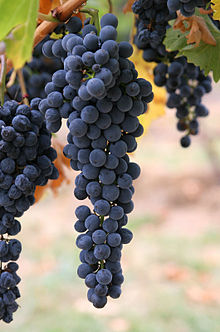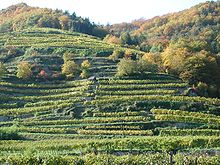Wine
![]()
This article explains the alcoholic beverage. For other meanings, see Wine (disambiguation).
Wine (via Middle High German and Old High German wīn from Latin vinum) is an alcoholic beverage made from the fermented juice of the berries of the noble vine (Vitis vinifera). Wine is a stimulant and intoxicant. Through specific oenological cultivation methods, numerous biochemical ripening processes occur during storage, which can be very diverse and also lead to some wines ripening and lasting for decades.
The most common wines are red, white and rosé wines. Sparkling wine (sparkling wine, cava, champagne, etc.) is made from wine during a second fermentation. Low-foaming wines are called sparkling wines (Prosecco frizzante, Secco etc.). As a rule, carbon dioxide is technically added to the wine.
The berry fruits required for wine production grow in grape-like, elongated panicles on the grapevine (Vitis vinifera). They are mainly derived from its subspecies, the European noble vine Vitis vinifera subsp. vinifera. As this vine is not resistant to phylloxera, it is grafted onto partially resistant rootstocks (roots) of the wild vine species Vitis riparia, Vitis rupestris, Vitis berlandieri or their interspecific crosses (hybrid vines) to protect it from phylloxera.
Technical terms on the subject of wine are explained in the article wine language.

Wine is a cultural product, made from the fermented juice of the grape.

... and landscape (Photo: Wachau).

Where wine is cultivated, unique cultural landscapes have often emerged: Sustainable fabric of culture (Photo: Radebeul) ...
Definitions
- Trade description wine: Only a beverage derived from fruit of the vine may bear the trade description "wine" (without further explanation). According to the legislation in the EU, a wine must contain at least 8.5% alcohol by volume.
- Wines in the broader sense are also referred to as:
- Liqueur wines or fortified wines: Fortified wines usually have their alcohol content increased by the addition of brandy (fortification). As the yeasts die at 17.5 percent alcohol by volume, the fermentation can be stopped and the residual sweetness is maintained. Fortified wines include Madeira, Marsala, Sherry, Port, the Vin Doux Naturel Banyuls and the Swiss Glacier Wine.
- Sparkling wines: French crémant and champagne, German Sekt and Winzersekt, Spanish cava and Italian spumante are considered sparkling wines - due to the content of bubbling carbon dioxide gas with a pressure of more than 3 bar. Due to a pressure of less than 2.5 bar in the bottle, the German sparkling wine, the French vin pétillant and the Italian frizzante are called semi-sparkling wine.
- Unfermented wine: Wine which is still drunk during the fermentation phase is sold under the generic term "new wine" as "Federweißer", "Federroter", "Sauser", "Sturm", "Bremser" or similar.
- Wine-based drinks contain other substances besides wine - for flavouring or for dilution. Wine-based drinks include Sangría, Vermouth, Weinschorle (in Austria also called Gespritzter or G'spritzter).
- Wine-like beverages are those which are not made from the juice of the berries of the vine, but from the fructose-containing juice of other fruits or from other sugary raw materials, such as fruit wine, mead (from honey), rhubarb wine. Wines made from fruits other than grapes must always include the name of the fermented fruit (for example, wine made from apples = cider). Fermented products made from starchy raw materials such as rice wine are not called wine-like beverages.

A glass of red wine and a glass of white wine

Roman wine, Speyer around 325, found in the ground in 1867, considered to be the oldest preserved grape wine in the world (Historical Museum of the Palatinate, Speyer)
Etymology
"Wine" is a classical wandering word that was common throughout the Mediterranean region. The Arabic wayn, the Latin vinum, the Greek οἶνος [oínos] or *ϝοῖνος [woínos] - from myk. wo-no - are related to each other, without it being possible to deduce from which language it originated. Presumably, a similar connection can be drawn to the Georgian word ღვინო [ghwino]. It should be noted that only the Georgian word ghwino has a different meaning and means "boiling".
The High German word Wein (from Old High German wîn or winam) as well as English wine, Welsh gwin and Irish fíon are all borrowed from Latin vinum or Provincial Latin vino, while French vin (cf. Old French li vins) goes back directly to the Latin word. This can be explained by the fact that both Germanic and Celtic peoples first came into contact with wine on a larger scale via the Romans and thus adopted the Latin word.
Through later trade relations, the concept of wine passed from the Germanic tribes to the Slavs (see the Russian word vinó) and to the Balts, where, for example, the word vynas is known in Lithuania and the word vins in Latvia.
The Latin vinum is probably borrowed from a Mediterranean or Pontic language.
Questions and Answers
Q: What is wine?
A: Wine is an alcoholic drink made from the juice of grapes.
Q: Are there other types of wine?
A: Yes, some people also refer to alcoholic drinks made from the juice of other fruits (such as plums or blackberries) as "wine".
Q: Is this article about all types of wine?
A: No, this article only deals with wine made from grapes.
Q: How is wine usually described?
A: Wine is usually used to talk about drinks made from the juice of grapes.
Q: Does wine contain alcohol?
A: Yes, it does contain alcohol.
Q: What type of fruit can be used to make wine?
A: Grapes are typically used to make wine, although some people also use other fruits such as plums or blackberries.
Search within the encyclopedia